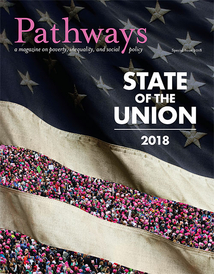State of the Union 2018

The annual Poverty and Inequality Report provides a unified analysis that brings together evidence across such issues as poverty, employment, income inequality, health inequality, economic mobility, and educational access to allow for a comprehensive assessment of where the country stands. In this year’s issue, the country’s leading experts examine gender inequalities in the United States.
Table of Contents (Special Issue 2018)
The traditional gender binary just doesn’t work. When respondents of a national survey were asked about their femininity and masculinity, 7 percent considered themselves equally feminine and masculine, and another 4 percent responded in ways that did not “match” their sex at birth (i.e., females who saw themselves as more masculine than feminine, or males who saw themselves as more feminine than masculine).
Despite common beliefs to the contrary, male students do not consistently outperform female students in mathematics. It’s only in high school that the male advantage in mathematics surfaces. What’s going on?
For women and men alike, life expectancy has stagnated for the last several years, primarily due to increases in drug poisoning deaths and in the suicide rate. The male-female life expectancy gap, which favors females, fell from 7.6 years in 1970 to 4.8 years in 2010, a reduction of more than one-third.
After rising steadily for many decades, the overall female employment rate has been falling since 2000. Why has it fallen? Are there straightforward policy fixes that could increase women’s employment?
When gender differences in labor force participation, fringe benefits, and self-employment income are taken into account, women earn only 57 cents for each dollar earned by men.
Are women more likely than men to be in deep poverty, official poverty, and near poverty? Yes, yes, and yes.
Why do women use safety net programs more than men? A hint: It’s not just because they’re more likely to be eligible for them.
Nearly half of the women in the labor force would have to move to a different occupation to eliminate all occupational segregation by gender. This is a classic case of stalled change: If recent rates of change are extrapolated, it would take 330 years to reach full integration.
A new science of gender discrimination is being built with audit studies and other experiments. A key result: Gender discrimination is more likely to emerge when the applicant’s commitment to work can be called into question or when an applicant is behaving in a gender-nonconforming way.
The workplace is rife with sexual harassment. By age 25 to 26, one in three women and one in seven men experience behavior at work that they define as sexual harassment.
Although men used to have more social ties than men, now the gender gap has reversed and women have the larger networks. But women still have fewer coworker ties than men … and coworker ties matter a lot.
What are the most promising science-based policies for reducing gender inequality at home and in the labor market?
